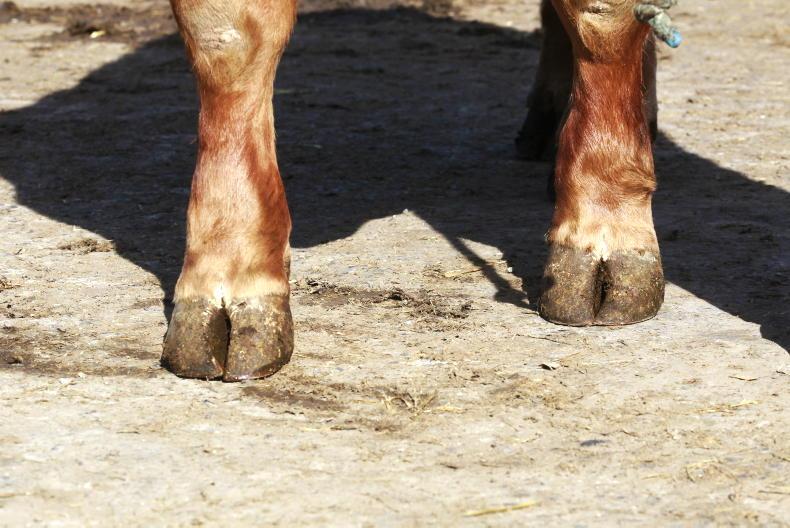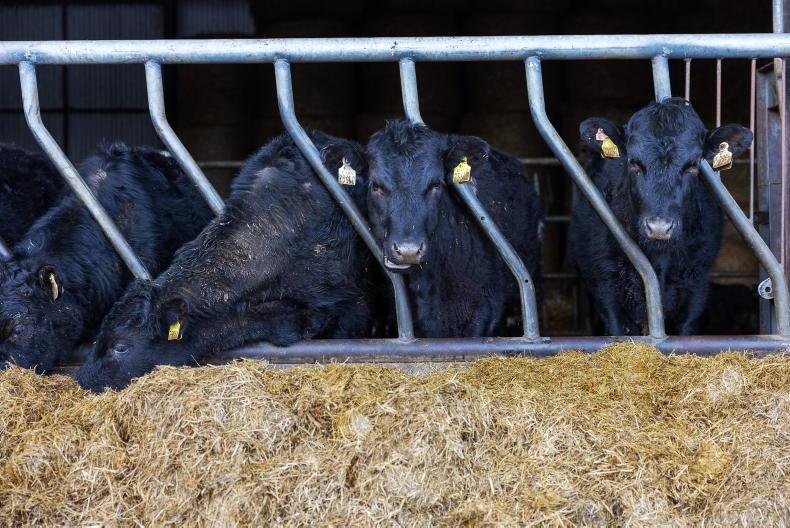Farmers are the custodians of the nation’s carbon, yet get little recognition for this role, dairy farmer Hugh Harbison told attendees at the Ulster Grassland Society (UGS) annual conference.
Hugh runs an autumn calving herd of 180 cows on 100ha of grassland at Aghadowey, Co Derry.
Cows are a cross between Scandinavian Red, Jersey and British Friesian, yielding 8,626 litres/annum from 2.5t of concentrate at 4.44% butterfat and 3.54% protein.
Hugh’s farm is one of seven participating in the ARC Zero project, a European Innovation Partnership which aims to drive positive change towards carbon zero farming.
“The reason I joined ARC Zero was because farmers have taken a bashing about pollution but I felt we have a positive story to tell. The project’s focus is on verifiable information to produce a net annual greenhouse gas emissions (GHG) report for the farm,” said Hugh.
In spring 2021, baseline data was collected through soil testing, with a LiDAR (Light Detection and Ranging) survey also done to assess how much carbon is stored above ground.
Surveying
“We have 18.78km of hedgerows on farm measuring anywhere from 4m to 10m in height. It was interesting that 3.89km of hedges measuring 10m in height is storing 229t of carbon, four times more than 10.3km of hedges measuring 4m high,” said Hugh.
A further 4.5ha of deciduous woodland is storing 145t of carbon, and overall, the Harbinson farm is storing 538t of carbon through trees and hedges.
The LiDAR survey also highlighted areas on the farm that are high risk for nutrient run-off into watercourses.
As a result, a seven acre paddock was sown out in a multi-species sward last August. “The goal is that the herbal ley will need less nitrogen, reducing the nutrient run off risk and capturing more carbon, which is a win-win for us,” said Hugh.
Net emissions
Based on the output from Scotland’s Rural College (SRUC) carbon calculator, Agrecalc, the farm has a net emissions figure of just over 2m kg of carbon dioxide (CO2) equivalents coming from farming inputs and livestock.
This is reduced by 27% to 1.46m kg once the carbon sequestered from soil and woodland is taken into account.
Mitigations
“The report flagged some areas we can improve on, and reducing cow size is one we are targeting. Moving from a 650kg to a 500kg cow will reduce net emissions by another 10%. But this has to stack up financially.
We did our sums for smaller cows, producing 5% less milk, but with 0.24% more butterfat, 0.14% more protein and consuming 2kg/day less concentrate. Margin over concentrate increased by £15,000 with smaller cows,” said Hugh.
Other areas include clover, which has the potential to reduce emissions from anywhere between 3% and 6%, while at the same time achieving a 30% to 60% drop in chemical nitrogen use.
Ultimately, more clover will also lead to significant financial savings on the farm.
The other side of the carbon story
During his presentation at the UGS annual conference Ballymena suckler farmer, Billy O’Kane outlined the outcomes of a carbon audit on his 500 acre farm which carries 250 spring calving cows.
“We are only hearing one side of the story around carbon and emissions, so I was keen to get a handle on what my farm was releasing each year and more importantly, what it was capturing” said Billy.
Data collection was done in 2020, with the information analysed through Alltech’s
E-CO2 system.
Results showed that the farm sequesters 181t of carbon annually (659t CO2 equivalents/year), based on 13ha of woodland capturing 37.7t of carbon, 44km of hedgerows taking in 44t and grassland capturing 99t/yr.
That compares to 1,218t CO2 equivalents released annually from livestock and inputs used.
Conflicting analysis
The industry standard method for measuring emissions is the Global Warming Potential (GWP) 100 system.
However, this model does not recognise that methane is a short-lived gas in the atmosphere, unlike CO2 from fossil fuel burning which lasts for centuries.
Research has shown that if livestock numbers remain constant, GWP100 overvalues methane’s impact on global warming by a factor of 3.5 to 4. An alternative metric, known as GWP* allows for the different characteristics of methane when compared to other greenhouse gases.
“Under the GWP 100 system, the farm is only 54% carbon neutral. However, using the more modern GWP* system developed by Oxford University, the farm is carbon neutral and in fact is 5% higher than being neutral,” said O’Kane.
Efficiency
He also maintained that there is a 40% cut in emissions to be had by utilising a combination of techniques, including selecting top genetics with higher feed efficiency, calving heifers at 24 months, bull beef finishing and reducing mature cow size.
“While I want to improve the farm’s carbon footprint, all of these factors also deliver more profit for my business,” he said.
Beckett wins grassland award
Claire Beckett made history last week as the first female farmer to win the UGS grassland farmer of the year award sponsored by Danske Bank.
Milking 150 Holstein cows in partnership with her father at Donaghcloney, the herd yields 10,300 litres/cow at 4.3% butterfat and 3.4% protein. Milk from forage is just under 3,000 litres/cow.
Judges remarked on the level of data recording in place on the farm and how that data has been used to manage cow diets and grazing, and ultimately added 1,500 to 2,000 litres to yields in recent years.
A total of 16t of grass dry matter per hectare (DM/ha) was grown on the grazing platform in 2021. The herd averages 4.2 lactations with a calving interval of 373 days and 75% of cows calved during September and October 2021, up from 56% in the previous year.
Runners up
Castlewellan suckler and sheep farmer John Milligan, and Banbridge dairy farmer, Gordon Mitchell, were runners up in the competition.
John runs 90 spring calving cows and 450 sheep on 180 acres. Grass grown in 2021 was 13t DM/ha on the grazing platform.
Gordon Mitchell milks 80 autumn calving cows with wife Linda on 170 acres. From 2016 to 2021, milk yield increased from 6,400 litres to 8,200 litres/cow.
During the same period, milk from forage increased from 2,800 litres to 3,400 litres with milk solids also rising. Calving interval is 366 days, and last year the farm yielded 13.4t DM/ha.
Special commendation awards went to dairy farmer Jonny Hutchinson from Tobermore and beef and sheep farmer, Dale Orr from Downpatrick.
Targeting emissions can deliver lower costs
There are many opportunities for farmers to lower their carbon footprint while at the same time reducing their costs
of production, maintained Dr Steven Morrison from AFBI.
He said that for a typical suckler system in NI, the baseline is around 36kg CO2 equivalents per kg of deadweight produced.
“Reducing age at first calving to 24 months can lower the baseline figure by 6.9%. Reducing slaughter age to 18 months can lower emissions by 12.5%, with improved grassland management worth 8%. These measures all deliver financial benefits,” he said.
Morrison also pointed out that capturing carbon in soil increases organic matter, which ultimately improves soil health, function and productivity.
Caution
However, Professor Gary Lanigan from Teagasc cautioned that higher efficiency on farms, can often lead to more production and higher stocking rates. So while carbon footprint per head is reduced, overall farm emissions are not.
“We need to promote other technologies such as legumes, tree planting and fertiliser type as well,” said Lanigan, who added that allowing hedges to grow out to 1m wide and 2m tall results in capturing an extra 4t of carbon for every kilometre.
The Teagasc researcher suggested that in order to get real engagement, the price of carbon and emission reductions need to be commoditised with the farmer getting the full market value.
“This is something the EU is looking at developing and it could allow farmers to trade carbon credits to other sectors. Before that, we need to ensure how we measure carbon is properly verified otherwise the market will lose integrity,” he said.
Read more
Fonterra revises milk price upwards for third time
Stolen farm equipment worth 'about €8,000' recovered in Co Mayo
Farmers are the custodians of the nation’s carbon, yet get little recognition for this role, dairy farmer Hugh Harbison told attendees at the Ulster Grassland Society (UGS) annual conference.
Hugh runs an autumn calving herd of 180 cows on 100ha of grassland at Aghadowey, Co Derry.
Cows are a cross between Scandinavian Red, Jersey and British Friesian, yielding 8,626 litres/annum from 2.5t of concentrate at 4.44% butterfat and 3.54% protein.
Hugh’s farm is one of seven participating in the ARC Zero project, a European Innovation Partnership which aims to drive positive change towards carbon zero farming.
“The reason I joined ARC Zero was because farmers have taken a bashing about pollution but I felt we have a positive story to tell. The project’s focus is on verifiable information to produce a net annual greenhouse gas emissions (GHG) report for the farm,” said Hugh.
In spring 2021, baseline data was collected through soil testing, with a LiDAR (Light Detection and Ranging) survey also done to assess how much carbon is stored above ground.
Surveying
“We have 18.78km of hedgerows on farm measuring anywhere from 4m to 10m in height. It was interesting that 3.89km of hedges measuring 10m in height is storing 229t of carbon, four times more than 10.3km of hedges measuring 4m high,” said Hugh.
A further 4.5ha of deciduous woodland is storing 145t of carbon, and overall, the Harbinson farm is storing 538t of carbon through trees and hedges.
The LiDAR survey also highlighted areas on the farm that are high risk for nutrient run-off into watercourses.
As a result, a seven acre paddock was sown out in a multi-species sward last August. “The goal is that the herbal ley will need less nitrogen, reducing the nutrient run off risk and capturing more carbon, which is a win-win for us,” said Hugh.
Net emissions
Based on the output from Scotland’s Rural College (SRUC) carbon calculator, Agrecalc, the farm has a net emissions figure of just over 2m kg of carbon dioxide (CO2) equivalents coming from farming inputs and livestock.
This is reduced by 27% to 1.46m kg once the carbon sequestered from soil and woodland is taken into account.
Mitigations
“The report flagged some areas we can improve on, and reducing cow size is one we are targeting. Moving from a 650kg to a 500kg cow will reduce net emissions by another 10%. But this has to stack up financially.
We did our sums for smaller cows, producing 5% less milk, but with 0.24% more butterfat, 0.14% more protein and consuming 2kg/day less concentrate. Margin over concentrate increased by £15,000 with smaller cows,” said Hugh.
Other areas include clover, which has the potential to reduce emissions from anywhere between 3% and 6%, while at the same time achieving a 30% to 60% drop in chemical nitrogen use.
Ultimately, more clover will also lead to significant financial savings on the farm.
The other side of the carbon story
During his presentation at the UGS annual conference Ballymena suckler farmer, Billy O’Kane outlined the outcomes of a carbon audit on his 500 acre farm which carries 250 spring calving cows.
“We are only hearing one side of the story around carbon and emissions, so I was keen to get a handle on what my farm was releasing each year and more importantly, what it was capturing” said Billy.
Data collection was done in 2020, with the information analysed through Alltech’s
E-CO2 system.
Results showed that the farm sequesters 181t of carbon annually (659t CO2 equivalents/year), based on 13ha of woodland capturing 37.7t of carbon, 44km of hedgerows taking in 44t and grassland capturing 99t/yr.
That compares to 1,218t CO2 equivalents released annually from livestock and inputs used.
Conflicting analysis
The industry standard method for measuring emissions is the Global Warming Potential (GWP) 100 system.
However, this model does not recognise that methane is a short-lived gas in the atmosphere, unlike CO2 from fossil fuel burning which lasts for centuries.
Research has shown that if livestock numbers remain constant, GWP100 overvalues methane’s impact on global warming by a factor of 3.5 to 4. An alternative metric, known as GWP* allows for the different characteristics of methane when compared to other greenhouse gases.
“Under the GWP 100 system, the farm is only 54% carbon neutral. However, using the more modern GWP* system developed by Oxford University, the farm is carbon neutral and in fact is 5% higher than being neutral,” said O’Kane.
Efficiency
He also maintained that there is a 40% cut in emissions to be had by utilising a combination of techniques, including selecting top genetics with higher feed efficiency, calving heifers at 24 months, bull beef finishing and reducing mature cow size.
“While I want to improve the farm’s carbon footprint, all of these factors also deliver more profit for my business,” he said.
Beckett wins grassland award
Claire Beckett made history last week as the first female farmer to win the UGS grassland farmer of the year award sponsored by Danske Bank.
Milking 150 Holstein cows in partnership with her father at Donaghcloney, the herd yields 10,300 litres/cow at 4.3% butterfat and 3.4% protein. Milk from forage is just under 3,000 litres/cow.
Judges remarked on the level of data recording in place on the farm and how that data has been used to manage cow diets and grazing, and ultimately added 1,500 to 2,000 litres to yields in recent years.
A total of 16t of grass dry matter per hectare (DM/ha) was grown on the grazing platform in 2021. The herd averages 4.2 lactations with a calving interval of 373 days and 75% of cows calved during September and October 2021, up from 56% in the previous year.
Runners up
Castlewellan suckler and sheep farmer John Milligan, and Banbridge dairy farmer, Gordon Mitchell, were runners up in the competition.
John runs 90 spring calving cows and 450 sheep on 180 acres. Grass grown in 2021 was 13t DM/ha on the grazing platform.
Gordon Mitchell milks 80 autumn calving cows with wife Linda on 170 acres. From 2016 to 2021, milk yield increased from 6,400 litres to 8,200 litres/cow.
During the same period, milk from forage increased from 2,800 litres to 3,400 litres with milk solids also rising. Calving interval is 366 days, and last year the farm yielded 13.4t DM/ha.
Special commendation awards went to dairy farmer Jonny Hutchinson from Tobermore and beef and sheep farmer, Dale Orr from Downpatrick.
Targeting emissions can deliver lower costs
There are many opportunities for farmers to lower their carbon footprint while at the same time reducing their costs
of production, maintained Dr Steven Morrison from AFBI.
He said that for a typical suckler system in NI, the baseline is around 36kg CO2 equivalents per kg of deadweight produced.
“Reducing age at first calving to 24 months can lower the baseline figure by 6.9%. Reducing slaughter age to 18 months can lower emissions by 12.5%, with improved grassland management worth 8%. These measures all deliver financial benefits,” he said.
Morrison also pointed out that capturing carbon in soil increases organic matter, which ultimately improves soil health, function and productivity.
Caution
However, Professor Gary Lanigan from Teagasc cautioned that higher efficiency on farms, can often lead to more production and higher stocking rates. So while carbon footprint per head is reduced, overall farm emissions are not.
“We need to promote other technologies such as legumes, tree planting and fertiliser type as well,” said Lanigan, who added that allowing hedges to grow out to 1m wide and 2m tall results in capturing an extra 4t of carbon for every kilometre.
The Teagasc researcher suggested that in order to get real engagement, the price of carbon and emission reductions need to be commoditised with the farmer getting the full market value.
“This is something the EU is looking at developing and it could allow farmers to trade carbon credits to other sectors. Before that, we need to ensure how we measure carbon is properly verified otherwise the market will lose integrity,” he said.
Read more
Fonterra revises milk price upwards for third time
Stolen farm equipment worth 'about €8,000' recovered in Co Mayo










SHARING OPTIONS